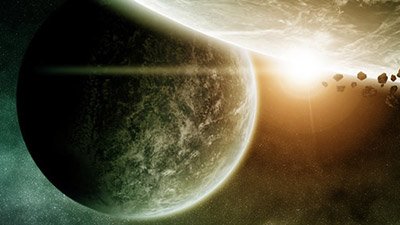
Leaning Tower of Planet Formation
PhysOrg: “Odd Discovery May Help Refine Theories About How Planets Form” A planet with a “steeply tilted” orbit—will it help refine theories of planetary formation or reveal their flaws?
Calling planet XO-3b “strange” might be an understatement. Like most other exoplanets discovered so far, it is large—an incredible 13 times as massive as Jupiter. But its orbit around its star takes only 3.5 days, far less than even Mercury. That makes it “unusual, even by the standards of exoplanets,” noted physicist Joshua Winn of the Massachusetts Institute of Technology.
Its orbit around its star takes only 3.5 days, far less than even Mercury.
Even stranger is the angle of XO-3b’s orbit relative to its star’s rotation. Based on spectrographic techniques, Winn’s team discovered that XO-3b’s orbit is tilted 37 degrees off of its star’s equator.
Traditional long-age theories of planetary formation are based on observations of our own solar system, in which the planets (excepting dwarf planet Pluto) orbit in the plane of the sun’s equator. These theories posit a spinning disc from which the sun and all the planets coalesced, explaining the common plane and orbital direction. Any discrepancies (such as Venus’s retrograde rotation) are typically blamed on cosmic collisions or atmospheric anomalies.
But how could XO-3b have ended up so far off the mark in its orbit, yet so close to its parent star? While astronomers guess at possible gravitational influences, Winn believes it will take more research to understand “how the dice get rolled in other solar systems.”
That’s where we come in. Obviously, Winn presupposes that dice do get rolled when it comes to solar system formation. But creationists aren’t limited to the role of chance. When we discover anomalies, we aren’t committed to torturing the facts to support a naturalistic explanation. Of course, this difference may seem minor when the issue is the tilted orbit of planet XO-3b, or even Venus’s retrograde rotation. But the difference is substantial when the question is why Earth is uniquely habitable, or when secular astronomers suggest an infinite number of universes to explain why physical constants are “just right” for life.
For more information:
Remember, if you see a news story that might merit some attention, let us know about it! (Note: if the story originates from the Associated Press, Fox News, MSNBC, the New York Times, or another major national media outlet, we will most likely have already heard about it.) And thanks to all of our readers who have submitted great news tips to us.
(Please note that links will take you directly to the source. Answers in Genesis is not responsible for content on the websites to which we refer. For more information, please see our Privacy Policy.)
Recommended Resources

Answers in Genesis is an apologetics ministry, dedicated to helping Christians defend their faith and proclaim the good news of Jesus Christ.
- Customer Service 800.778.3390
- © 2024 Answers in Genesis







